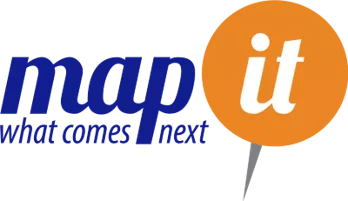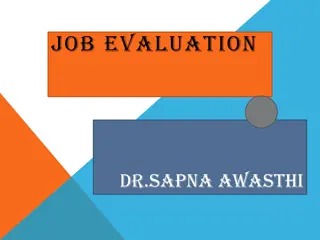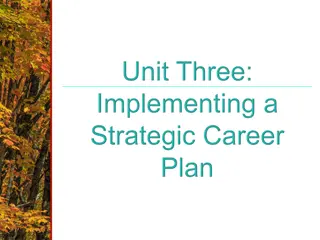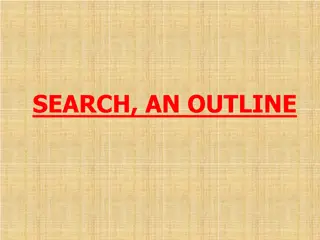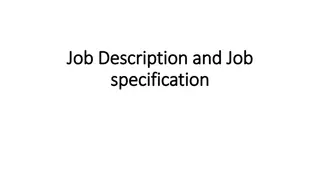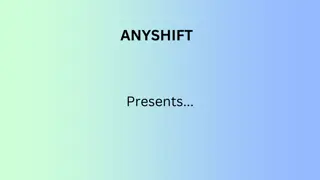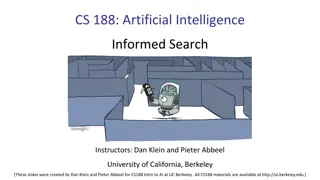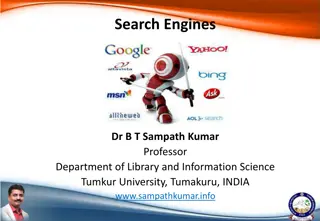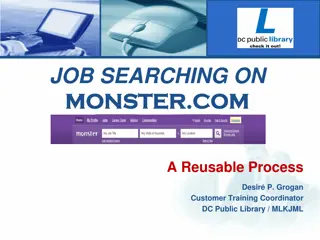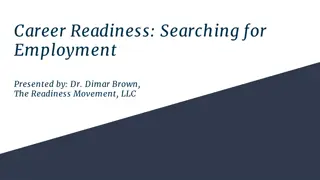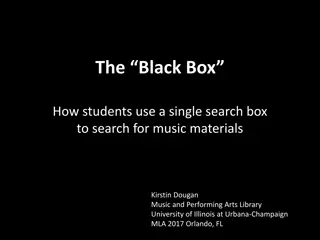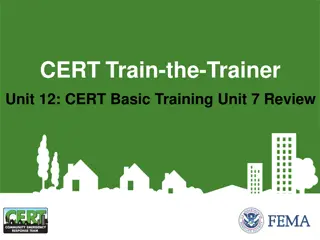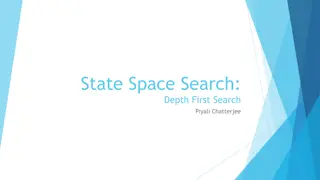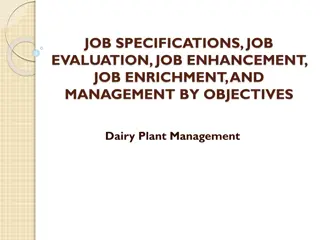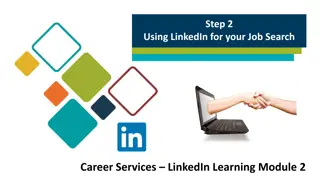Job Search Learning Activities for Students
Explore a series of engaging learning activities designed to help students analyze job compatibility, conduct job searches based on interests and skills, and enhance interview skills. Dive into real-life stories, discussions, and role-playing exercises to develop essential job search skills and insights.
Download Presentation

Please find below an Image/Link to download the presentation.
The content on the website is provided AS IS for your information and personal use only. It may not be sold, licensed, or shared on other websites without obtaining consent from the author.If you encounter any issues during the download, it is possible that the publisher has removed the file from their server.
You are allowed to download the files provided on this website for personal or commercial use, subject to the condition that they are used lawfully. All files are the property of their respective owners.
The content on the website is provided AS IS for your information and personal use only. It may not be sold, licensed, or shared on other websites without obtaining consent from the author.
E N D
Presentation Transcript
Job Search Learning Objectives: Students can analyze if a job matches interests, skills and transition goals. Students can perform a job search based on interests, skills and transition goals.
Meet Cathy Noble from pepnet 2s Getting a Job Online Training: Part 2: Rights and Responsibilities, Role Model: Cathy Noble, http://lms.pepnet.org/getting_a_job/rr_role_model.php (13:08). Job Search: Kick-off Activity Focus on understanding Cathy s personal story and the different types of accommodations that gave her equal access throughout her career experience.
Job Search: Discuss the following questions: What is the video about? What is interesting about Cathy s story? Classroom Activity What are the differences between Cathy s first job and second job? Name a few influential experiences from Cathy s life. How has Cathy s life experiences helped shape her identity? Name one of Cathy s occupational mismatches. Why wasn t it a good fit? Any other thoughts?
Map It Online Activity: 1. Reflect on Brooke and Marissa s conversation regarding finding the right fit and where they are in the job search process. Who do you relate to most, Brooke or Marissa? Why? 2. Review the pn2 Research Brief on Employment located in Map It resource section, http://lms.pepnet.org/mi/resources/employmentbrief_v5.pdf . What are your thoughts on the disparity that exists between DHH students and hearing peers? How does this relate to finding the right fit , self-determination, accommodation, and self-advocacy? Consider how educational attainment impacts your average annual income. The Next Step and The Fit is Important
Analyze the different key traits and skills employers are looking for in a future employee by reviewing the following job descriptions. Job Search: Job Description Activity With your group, visit each work center and analyze the different job information. Take notes on the traits and skills of a dream employee from the perspective of the employer in each setting. Once complete, discuss similarities and differences between groups.
Job Search: Now that you ve investigated the perspective of an employer, role play an entry level job interview at one of the center settings. Start by choosing a preferred setting and wait for your teacher to match you with a peer. Next, decide who will start off as the employer and who will be the (potential) employee. Employers- Use the Job Interview Activity handout to start the interview process. Next, switch roles. Mock Interview Activity Whole Class Discussion: Based on your observations, what worked and what didn t work? If you were an employer, what skills would you look for during an interview? Why is it good to prepare for an interview? Other thoughts or concerns about the interview process?
Job Search: The purpose of informational interviews is to talk to people about their jobs to determine if the job matches interests and skills, make new contacts, practice communication skills, and gain confidence in job interviews. Determine which job or career you want to learn more about. 1. Select a person to interview- consider someone you know in the field (family member, friend, local business) or reach out to a company you re interested in working for in the future. Informational Interview Activity 2. Practice setting up an Informational Interview with a peer. Hello my name is _____________. I am interested in working in _________________. Do you mind if I take 10 minutes of your time to ask a few questions? 3. Prepare questions such as : What do you like and not like about the job? What is the setting? Office or outdoors? How do you learn the skills and knowledge about your job? What education is needed? Is there additional training needed? What are the day-to-day job duties? What skills will I need? What are the characteristics of the work culture? 4. Interview the individual and follow up with a personalized thank you note.
Job Search: Review the purpose of each agency mentioned in Map It Getting a Job: State Agencies slide: Practice locating available services and learn how to navigate program websites. Informational Interagency Collaboration Invite guest speakers for a presentation, Q&A, or round table discussion on services, eligibility, and application process. Learn more about VR s Order of Selection process and what it means to be an entitlement program by watching Pepnet 2- Getting a Job, Part 3: Introduction to Vocational Rehabilitation video, http://lms.pepnet.org/getting_a_job/vr_intro_vocat_rehab.php Learn more about One-Stop Career Center by watching Pepnet 2- Getting a Job, Part 3: One Stop Career Center. Have students review one-Stop Career Centers Support Document to access additional information, http://lms.pepnet.org/getting_a_job/vr_one_stop_career.php Complete Part 3: Vocational Rehabilitation or One-Stop Career Center slide as a whole class or as an activity exit slip, http://lms.pepnet.org/getting_a_job/vr_voc_oscc.php.
Job Search: In this activity, you will examine a work-related problem and analyze possible choices for solving the problem. Divide into 5-6 groups and develop a work setting problem (try to draw from your own experiences). Decision Making on the Job Write the work related problem on a piece of paper. Next, going clockwise, give your problem to your neighboring group and receive a new problem. With your group, come up with a possible solution and consider the positive and negative consequences. When finished, share your solution with the class. Offer feedback to other solutions.
Synthesis Activity: Start the Job Search process with a job that you ve analyzed to be a good fit (refer to Your Turn slide if needed). Once you have identified a job(s), do a job search with the below resources: One-stop Career Center: careeronestop.org O*NET Online: onetonline.org State Career Information System Career Central in Map It Local Job Service Center Social Networking opportunities Local newspaper classified section (hardcopy and/or online) Local college or university human resource department (explore work-study and other employment opportunities for college bound students) Start Job Search Process Review the job description, gather application materials, and complete the application professionally. Complete a mock interview with your teacher. Make sure to store a copy of all application materials in your Career Portfolio for ongoing access.
Job Search: Exit Slip Based on activities completed on the Map It Your Turn slide, list the job that is a good fit. Share your favorite part of Map It and why. Print off your completed Map It Profile and Certificate of Completion and place it in your Career Portfolio of ongoing access.
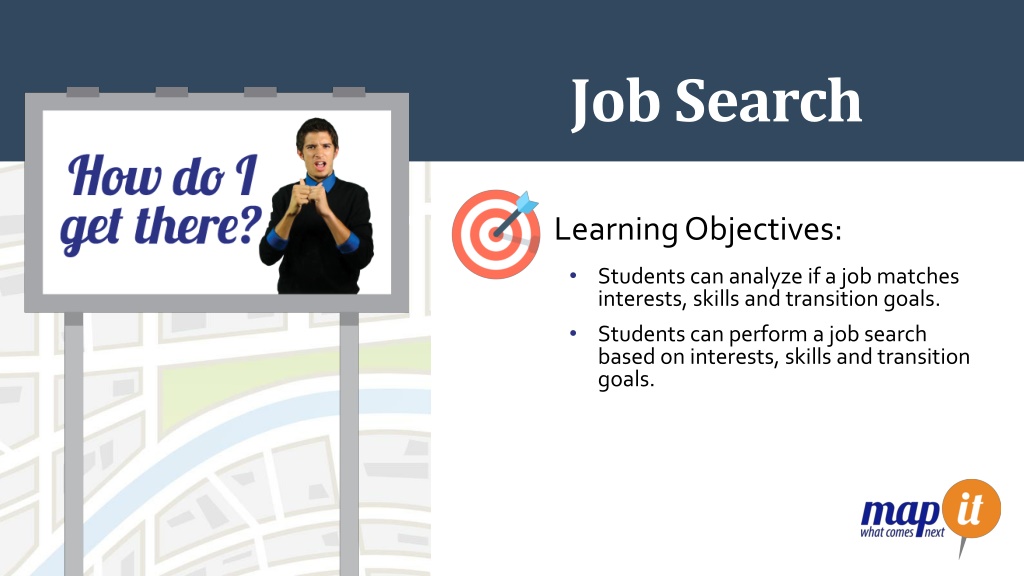
 undefined
undefined



